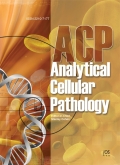Authors: Remmerbach, Torsten W. | Weidenbach, Horst | Pomjanski, Natalja | Knops, Kristiane | Mathes, Stefanie | Hemprich, Alexander | Böcking, Alfred
Article Type:
Research Article
Abstract:
Objective. The aim of this prospective study was to report on the diagnostic accuracy of conventional oral exfoliative cytology taken from white‐spotted, ulcerated or other suspicious oral lesions in our clinic. In addition we checked DNA‐image cytometry as an adjuvant diagnostic tool. Our hypothesis is that DNA‐aneuploidy is a sensitive and specific marker for the early identification of tumor cells in oral brushings. Study design. 251 cytological diagnoses obtained from exfoliative smears of 181 patients from macroscopically suspicious lesions of the oral mucosa and from clinically seemingly benign oral lesions which were exisiced for establishing histological diagnoses were compared with
…histological and/or clinical follow‐ups of the respective patients. Additionally nuclear DNA‐contents were measured after Feulgen restaining using a TV image analysis system. Results. Sensitivity of our cytological diagnosis on oral smears for the detection of cancer cells was 94.6%, specificity 99.5%, positive predictive value 98.1% and negative predictive value 98.5%. DNA‐aneuploidy was assumed if abnormal DNA‐stemlines or cells with DNA‐content greater 9c were observed. On this basis the prevalence of DNA‐aneuploidy in smears of oral squamous cell carcinomas in situ or invasive carcinomas was 96.4%. Sensitivity of DNA‐aneuploidy in oral smears for the detection of cancer cells was 96.4%, specificity 100%, positive predictive value 100% and negative 99.0%. The combination of both techniques increased the sensivity to 98.2%, specificity to 100%, positive predictive value to 100% and negative to 99.5%. Conclusions. Brush cytology of all visible oral lesions, if they are clinically considered as suspicious for cancer, are an easily practicable, cheap, non‐invasive, painless, safe and accurate screening method for detection of oral precancerous lesions, carcinoma in situ or invasive squamous cell carcinoma in all stages. We conclude that DNA‐image cytometry is a very sensitive, highly specific and objective adjuvant tool for the early identification of neoplastic epithelial cells in oral smears.
Show more
Keywords: Oral cancer, oral exfoliative cytology, DNA‐aneuploidy, DNA‐image cytometry, cancer screening, diagnostic accuracy
Citation: Analytical Cellular Pathology,
vol. 22, no. 4, pp. 211-221, 2001
Price: EUR 27.50





